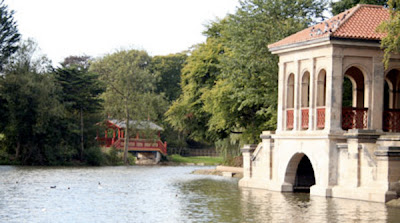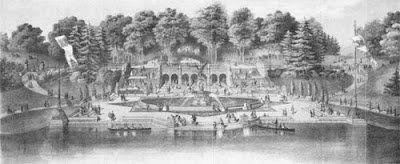It is estimated that the total amount of monocultured lawn in the United States exceeds the size of the state of Pennsylvania. Why?
Read More
British gardens
It is estimated that the total amount of monocultured lawn in the United States exceeds the size of the state of Pennsylvania. Why?
Read MoreGarden design ideas for using vines to cover trellises, pergolas, or other structures. Ivy can disguise an unflattering sightline at a small brownstone garden design.
Read MoreAlexander Pope said ‘‘all gardening is landscape-painting.’’ He laid the widely agreed principles of landscape architecture and design.
Read MoreSissinghurst is perhaps one of the most beloved gardens in all the world. For many it is the definitive English garden, evoking the poetic sensibilities of its creators, their deep feeling for history and rural tradition and the influence of their aristocratic upbringing and travels. A labor love created by...
Read MoreAccording to The Guardian, UK's ancient forests could be reproduced again after the country's supply has been severely depleted over several centuries of favoring farmland at the expense of forests. Contributing to this was Naval exploration, the industrial revolution and finally the two world wars when imports were difficult to obtain.
One of the largest oaks still stands in what is believed to be Sherwood Forest of Robin Hood fame. Another one of these super trees stands on the grounds of Blenheim Palace, designed by Lancelot "Capability" Brown, one of the most famous landscape designers.
Quercus alba (White oak) photographed on a late Spring day.
©todd haiman 2013
The word "hedge" appears to stem from the Old English word "HEGG" which is believed to be derived from the Anglo-Saxon words ;
HAEG - hurdle
HECG - territorial boundary dead or planted
HEGA - living border boundary
1
Hedges are a bordering and design tool. They enclose and subdivide fields, orchards, yards, parks and gardens. They form vegetative edges, topographic spaces, garden rooms, gateways, screens, enclosures, foci and forms within the landscape.
The term Hedgerow used to refer to 2 hedges running side by side separated by a track or pathway. These hedgerows served 2 traditional purposes , that of being a barrier to livestock and as a means of marking out territory or property boundaries. The term however tends to be used these days to describe a hedge of shrubs and occasional trees that create a border between fields and gardens or to create a privacy wall for a homeowner.
An extreme privacy hedge
www.dicts.info/img/ud/hedge.jpg
It is believed that the Romans may have first planted hedges in Britain but most of the few ancient hedges date from Saxon times, making some of them 1000 years old. The Saxons organized ‘strip farming’ in which each community of people would have a field which was divided into strips separated by grass verges. Each strip was one furrow long (one furlong or 201 metres). People were given a number of strips to farm by the lord of the manor. This system changed in the late Middle Ages when landlords wanted to put boundaries around their property, so they enclosed their land with walls or hedges. Enclosure Acts in the 18th and 19th centuries allowed farmers to put more hedges round their fields and most of Britain’s 300, 000 miles or so of hedges date from this time.
“During the 16
th
and 17
th
centuries, dense hedgerow patterns provided shelter for persecuted Protestants in France and Holland to organize their clandestine religious meetings. During the WW II the dense bocage in Normandy caused the invading Allied forces much trouble in advancing to conquer the Nazi regime.”
2
In the past hawthorne (
Crataegus monogyna)
was the most popular choice for hedgerows in the ancient woodland for marking territory or as barriers to contain livestock. Nowadays hedges are commonly constructed of various plant and non-plant material for more ornamental purposes yet still as a privacy tool. Boxwood, Privet, Beech, Cherry Laurel, Hedge Maple, Hornbeam, Holly and Yew are but a few of the more desirous plants used currently for hedges.
Designer Luciano Giubbilei's masterful use of hedges at a Chelsea Flower Show garden in 2009
1. Hedgerows, Hedges and Verges of Britain and Ireland
2. Natural History Museum of Britain. www.nhm.ac.uk/index.html
*all photos copyright Todd Haiman unless otherwise noted
The Catskill Mountains and Hudson River Valley in New York State were the inspiration for a group of painters in the early to mid 1800’s - The Hudson River School. It is through their eyes that we have a sense of that original landscape. As development and climate change continue to change our landscape it is their depiction that we consider an accurate indication of that virginal world.
Sketching outdoors, these artists paid careful attention to the correct rendering of the minute details of the landscape, although they were not afraid to literally move mountains in order to create an effect that would fit their sense of the “Picturesque.”
While the great European landscape painters traditionally inspired them, the Hudson River artists, were in search of an art form that would allow them to express and celebrate that which set America apart from Europe. And they found it in the paintings that captured the grandeur of the American Landscape.
“Kindred Spirits” is perhaps one of the best known of these paintings. The painting by Asher Durant, depicts his friend, the deceased painter Thomas Cole and the poet William Cullen Bryant standing on a rocky ledge overlooking the Catskills
It is titled after a phrase in a Keats sonnet and has long been considered one of the finest examples of Hudson River School painting. It was commissioned by Jonathan Sturges, one of Durand's most important patrons, as a gift for Bryant, and it remained in the Bryant family until his daughter, Julia, donated it to the New York Public Library early in the 20th century. The painting’s idealized composition brings together several sites, including the Clove of the Catskills, Kaaterskill Falls and Fawn’s Leap, in a way that is not geographically possible.
The author Bill Bryson describes his affection for the painting....“It shows two men standing on a rock ledge in the Catskills in one of those sublime lost world settings that look as if they would take an expedition to reach, though the two figures in the painting are dressed, incongruously, as if for the office, in long coats and plump cravats. Below them, in a shadowy chasm, a stream dashes through a jumble of boulders. Beyond, glimpsed through a canopy of leaves, is a long view of gorgeously forbidding Blue Mountains. To right and left, jostling into frame, are disorderly ranks of trees, which immediately vanish into consuming darkness. I can’t tell you how much I would like to step into that view. The scene is so manifestly untamed, so full of an impenetrable beyond, as to present a clearly foolhardy temptation. You would die out there for sure -- shredded by a cougar or thudded with a tomahawk or just left to wander to a stumbling, confounding death. You can see that at a glance. But never mind. Already you are studying the foreground for a way down the stream over the steep rocks and wondering if that notch ahead will get you through to the neighboring valley. Farewell, my friends. Destiny calls. Don’t wait supper.”1
Bill Bryson continues to jest about the scene. He questions how much artistic license these painters took with replicating the scenery -- “Who, after all, is going to struggle with an easel and campstool and box of paints to some difficult overlook, on a hot July afternoon, in a wilderness filled with danger, and NOT paint something exquisite and grand?”
This painting hung in New York Public Library for decades until several years ago, when desperately needing funding, the Library sold it at auction to Walmart heiress, Alice Walton for 35 million dollars to display at her new museum.
New York art lovers reacted with outrage seeing it as a civic landmark. “60 Minutes” TV Correspondent Morley Safer commented that the “grand inherent irony is that all that Wal-Mart money was gleaned from the systematic destruction of the very American landscape Ms. Walton so expensively celebrates.”
Thomas Cole "Sunrise in the Catskill Mountains"
Frederick Church "Morning Looking East"
1. A Walk in the Woods: Bill Bryson, Broadway Books 1998
The formal layout of the beloved
rose garden includes a central yew hedge planted in a circle with four tall yew-lined paths leading away from it. This is known by it’s creator Vita Sackville-West as “the Rondel”.
Sissinghurst
photos: ©toddhaiman2011
Outside the Rondel, there are low, neatly clipped box hedges separating huge beds filled with roses. The rondel assists in masking an a geometric garden layout whereby the two garden paths and axes do not cross at perfect right angles. Some say a brilliant move by the designer correcting the obtuse positioning of the buildings they connect with, others claim that this was an error by a young worker on the estate who miscalculated while laying out the path. No matter, the end result all agree is breathtaking.
Vita Sackville-West pays homage to the surrounding countryside, which is dotted with oast houses by referring to this garden structure as a rondel. Rondel is an old Kentish word employed for the shape of the hop-drying floor in the
, where hops lay in mounds.
Oast houses are buildings designed for drying or
“kilning” hops as part of the beer making or brewing process.
They are true examples of vernacular architecture -- many of which have over time have been converted to homes. (Vernacular architecture is a term used to categorize methods of construction, which use locally available resources and traditions to address local needs and circumstances. Additional examples would be igloos and log cabins. Vernacular architecture tends to evolve over time to reflect the environmental, cultural and historical context in which it exists.)
Oast house photos, wikipedia
In “Sissinghurst, Portrait of a Garden”, the author Jane Brown believed that this hedged circle in yew is
“of Italian Inspiration.”
Rondels are also considered in architecture a circular window opening or the beadmolding of a capital. But, upon further research the word “rondel” is either from the old French or old English word “roont”, meaning round or small circle. Present inspiration for the rondel can be found in the London Underground as its logo. Past history also finds it as the logo for the RAF.
London Underground logo, wikipedia
Castlerigg stone circle/ wikipedia
Excuse the pun, but “coming full circle”, a roundel enclosure is a type of pre-Christian and prehistoric enclosure found in Europe. Stone circles. Timber circles,
enclosures are all examples of this. Stonehenge, a megalithic structure of stones is recently
believed by some to have had multiple rondel hedges surrounding it thousands of years ago
.
Queen Mary (in white) viewing the Chelsea show
As written in past years, I have an annual pilgrimage during the third week of May "across the Pond" to the Chelsea Flower Show in London. Here is a bit of context and history about what is referred to as "the Great Spring show.
England had been compared to a garden since at least the time of Shakespeare. This metaphor took on particular significance in the Victorian Era as it infiltrated visual, literary, and everyday culture in England. The garden came to represent two things for the English in the Victorian era: home in the face of a massive Empire, and stability in the face of industrialization and a perceived disintegration of society.
English citizens were spread across the globe, (see past post on Rudyard Kipling) and began to seek a symbol that would unify those at home, and that would serve as a memory of home for those in their colonies. This image was particularly significant during the Victorian Era as England expanded her empire and influence across the globe.
The English landscape garden is considered by some cultural historians England's most compelling contribution to the visual arts. During the eighteenth century, as England struggled to develop a national identity, the landscape garden was a continual source of pride to landowners, artists, poets and gardeners alike. Botanical Gardens were established in most major towns and many royal estates were opened to the public.
London Bobby (policeman) admiring floral displays
Women in 1940's reading the show's catalog
It is in the next generation, between the wars, that the English become routinely described--by themselves and by other Europeans--as "a nation of gardeners." This extended to middle- and lower-middle-class suburbanites, whose terraced and semi-detached houses and gardens offered certain elements in common with the grander country houses of the elitist classes.
The show, which ultimately grew out of this “religious zeal” was organized by the Royal Horticultural Society and has been a staple of the British social and cultural scene for nearly 150 years. This annual spring festival is held for five days each May and features designed gardens, a large variety of exotic plants and all the accoutrements, trappings and revelry of a great fair. The event is held on the grounds of London's Royal Hospital, and it is perhaps the most celebrated show of it’s kind.
Crowds in 1950 swarming the show
“In 1862, London's Royal Horticultural Society held its first Great Spring Show. The show was held in Kensington and featured an array of exotic plant species from around the world. Each year until 1888, the RHS continued with this annual event, gradually building up a loyal audience. In 1913 they decided to use the grounds of the Royal Hospital in Chelsea, which had hosted several successful rose exhibitions. The show at the Royal Hospital became known as the Chelsea Flower Show, though it is still officially named the Great Spring Show. From 1913 through 1916, the fair enjoyed unprecedented success. By 1917, World War I had devastated much of the region, and the fair was canceled for two years. In the 1920s, London's royal family began to visit the fair each year, starting a new tradition that continues to this day. Also during this time, the Chelsea tea parties began. These parties take place during the show and are a major draw for Britain's social and political leaders. The show was canceled again for several years during World War II. In 1947, though crops and supplies were limited, the Chelsea Flower Show was held as scheduled, and it became a symbol of the country's strength and determination to rebuild. By 1979, the show was so popular that crowds began to overwhelm the limited space. Throughout the next few years, ticket limits were set and attendance was restricted to help prevent injuries to attendees. Despite ticket limits, crowds continued to overwhelm the show until 1993, when parts of the show were relocated to other venues. Today, more than 150,000 visitors attend the show each year. All attendees must purchase tickets in advance, and the show holds an annual preview day specifically for the royal family and other honored guests. The BBC shows much of the event on television each year, to allow those who can't get tickets to take part in the experience. The Chelsea Flower Show is considered a place to spot the latest trends in floral and horticultural design, and it is eagerly attended by industry professionals and garden enthusiasts from around the world.”
1
previous five images of celebrities from bigpictures.com
1 -reprinted from RHS Show catalog
Born in Hartford, Connecticut and raised by his father, unable to attend Yale College because his eyesight had weakened due to sumac poisoning, Frederick Law Olmsted sailed off to China where he returned a year later with scurvy. After recovering, he set out his hand at farming on Staten Island, failing miserably to profit from his land holdings. Next he embarked for England and Wales with his brother whereupon they encountered magnificent estates, parks and rural scenery. Such was the indication of things to come. Most influential in his journeys were Joseph Paxton’s design for Birkenhead.
Paxton sought to bring the grandeur of the aristocratic garden to the working people of Birkenhead. The park was a declaration of civic pride to nearby Liverpool and an attempt to tempt wealthy taxpayers to either build or purchase homes in Birkenhead. It is widely believed to be the first civic park in Britain, but more importantly within this context it provide the inspiration and template for Olmsted (and Calvert Vaux's) work. Olmsted wrote "
"five minutes of admiration, and a few more spent studying the manner in which art had been employed to obtain from nature so much beauty, and I was ready to admit that in democratic America there was nothing to be thought of as comparable with this People’s Garden"."


Illustration and photograph of Birkenhead Park (youyesterday.com/flicker.com)
“Olmsted was much impressed with the meandering footpaths and open meadows spangled with rocks and scattered trees. He wondered how cleverly "art had been employed to obtain from nature so much beauty." And wonder of wonders, this was not just a sanctum for some noble lord but a park open to the public, a park for people of all stations in life. In all the cities of democratic America, he had to admit, there was nothing quite like it. Not yet, anyway.” National Geographic Magazine, March 2005.

Illustration of Central Park/Bethesda Terrace and fountain
Much has been written on Olmsted’s intriguing life, including the most recent bestseller “A Clearing in the Distance”by Witold Rybczynski. Thanks to the efforts of the Olmsted Legacy a film that was initially screened last year at select locations will now be coming to public television.
The Olmsted Legacy, with its name slightly tweaked to "Olmsted and America's Urban Parks" was aired appropriately on PBS for Earth Day, April 20th.